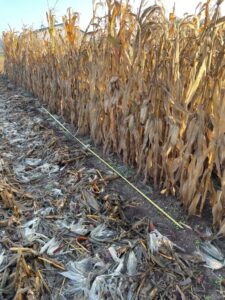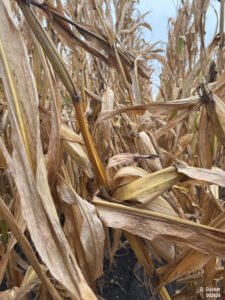Illinois Crop Update – September 27, 2024
Russ Higgins – Commercial Agriculture Educator
Grundy County
Soil Conditions: Mildly Dry (soil is drier than normal, plant growth may have slowed)
A widespread rainfall event passed through northeast Illinois putting a temporary hold on harvest activities. This pause gives growers the opportunity to visit fields and evaluate combine performance in harvested areas. This is also one of the easiest times to measure harvest populations in corn fields. For 30-inch rows, count the number of plants in 17 feet 5 inches and multiply by 1000 to determine population per acre. Winter annuals have started to grow, including Common chickweed and Henbit in northeast fields. Several reports of soy as dry as 9 percent moisture have been shared. The following recommendations originated from the University of Nebraska in reference to soybean harvest, “moisture content can increase by several points with an overnight dew or it can decrease by several points during a day with low humidity and windy conditions. Avoid harvesting when beans are driest, such as on hot afternoons, to maintain moisture and reduce shattering losses. Harvesting immediately after a rain, if field conditions allow, will result in higher moisture contents. However, several wetting and drying cycles from rain events will make the soybeans more susceptible to shatter losses from pods splitting open.” The full UNL article for equipment adjustment for harvesting soybean can be accessed at https://cropwatch.unl.edu/2017/tips-harvesting-soybeans-13-15-moisture

Figure 1: Measuring harvest population, 25 Sept. 2024

Figure 2: Winter annuals, 25 Sept. 2024

Figure 3: Soy pods, 25 Sept 2024
Meagan Diss – Commercial Agriculture Specialist
Knox County
Soil Conditions: Mildly Dry (soil is drier than normal, plant growth may have slowed)
Harvest is underway throughout the county for some producers while other fields are still shy of maturity. This week brought cooler temperatures, but we are still experiencing dry soils. We did see some scattered light showers in the morning on 9/24 but not enough to slow harvest. Be sure to check fire extinguishers and combines for buildup as we go into harvest, especially given the drier conditions. Have a safe and great harvest season!
Reagan Tibbs – Commercial Agriculture Educator
Logan County
Soil Conditions: Mildly Dry (soil is drier than normal, plant growth may have slowed)
Harvesting progress has slowed down significantly across Logan, Menard, and Sangamon counties due to rain over the last week. This rain, combined with rain forecast for later in the week, means that harvest may be delayed even further. Diseases such as tar spot in corn are beginning to show themselves, but no impacts on yield are expected this late in the growing season.

Figure 4: Tar spot on a corn plant near Lincoln, IL.
Doug Gucker – Local Food Systems and Small Farms Educator
Dewitt, Macon, and Piatt County
Soil Conditions: Mildly Wet (soil is wetter than normal, local vegetation is healthy)
Very welcome rains have been received over the past week with totals varying from less than 1″ to nearly 3″ in my 3-county area. Corn and soybean fields are being harvested with yields being reported as good. If you are planning on letting your corn dry in the field, please check those fields for their standability and whether they need to be harvested earlier rather than later. I ran across an area where the corn fields had suffered weather stress issues during the growing season and the stalk quality was not great (see Figure 5).

Figure 5: A field of corn that failed the Stalk Quality “Push” test.

Figure 6: Harvesting started last week with both corn and soybeans.
Talon Becker – Commercial Agriculture Specialist
Vermillion County
Soil Conditions: Mildly Wet (soil is wetter than normal, local vegetation is healthy)
After some needed rains came through the area, harvest has been stalled for a couple days in the region. But during my survey of southern Vermilion County, I saw a few combines parked in the field ready to get rolling again soon. Of the harvested fields I saw, it was about a 60/40 split, with more soybeans harvested than corn. At this time, I would estimate about 10% of the fields I passed by during my survey had been harvested. For the standing corn fields surveyed, the majority were at or within a couple days of R6 (black layer). Most soybean fields have made it at least into R7 (beginning maturity) with quite a few at R8 and just waiting for field conditions to dry up a bit more before being harvested.
Dane Hunter – Commercial Agricultural Specialist
Clinton County
Soil Conditions: Mildly Wet (soil is wetter than normal, local vegetation is healthy)
Southern Clinton County and into Washington has seen harvest begin as well as more than the north half of Marion County. Quite a few farms are working on corn fields here. Corn throughout the region seems to have hit black layer and is still a little on the wet side for the most part, but harvestable. First crop soybeans are defoliating quickly and double crops are just beginning to see a few tinges of yellow while still filling those top pods thanks to the rains the last couple weeks. This late season moisture is delaying harvest now but will surely boost double crop yields. I have seen one bean field harvested and drilled (presumably to wheat) as of today.





